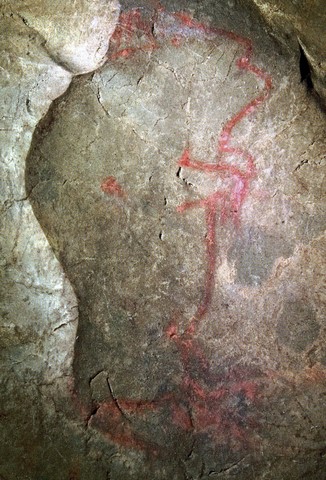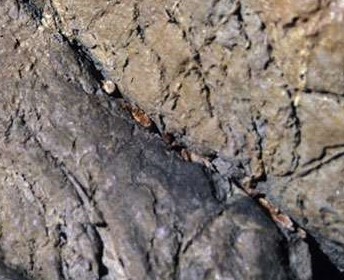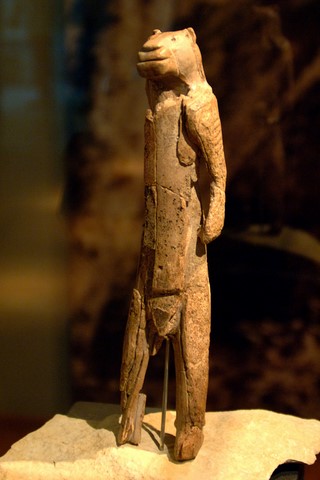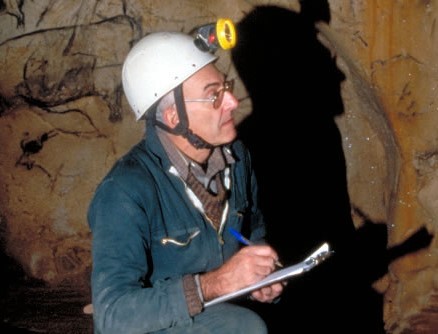Vertical bisons: was cave-painting a form of shamanism?

At which point the question arises of the meaning to be attributed to the very high quality of the images known to us from the parietal art of the Palaeolithic. It is of course out of the question to try quantifying the degree of excellence of paintings and engravings found at Lascaux, Chauvet, Altamira, Niaux, Font-de-Gaume and so many others; it is nevertheless certain that these drawings do not correspond to what we might expect to be produced by a chance sampling of any given population. Too many of them bear witness to a highly developed artistic sense and to an impressive mastery of techniques. From these evidence, we must deduce two things. On the one hand, it is obvious that some of these artists were supremely gifted. On the other hand, in order to arrive at this level of expertise, they must necessarily have exercised at length, or received a teaching – which would explain the perennity of parietal art.
These two remarks lead us into the domain of ethnology. In shamanic societies, the selection of a future shaman or shamans was of capital importance and many criteria came into play. Often, it was thought that it was the spirits who chose the person (and not the reverse). It would not be at all impossible that in the early Palaeolithic, one of the critera of choice would have been the innate capacity to draw, meaning, to master the reality of the visible world and to exert an influence upon it. That such a gift would have been developed, refined and channeled by the means of instruction would only be quite normal.
By contrast, the gauche and clumsy drawings which often coexist with the most glaring achievements could have been due to persons of a very different status who adventured into the depths of the caves in order to benefit from their supernatural power, maybe in the company of shamans. The imprints of hands and the digital drawings, and the numerous “parasite lines” as Abbé Breuil called them, would logically explain themselves within such a frame of reference, whereas no other of the earlier explanations could justify them. These persons touched the walls by various means, leaving their traces on it, and would then have captured some of the power through establishing a direct link with the forces of the beyond which they found there, literally, “at hand.”
The same logic applies to the bone splinters which were inserted or deposited in the cracks of the walls. Since we signaled then, they have been found in 18 French or Spanish caves to date. In several others, splinters of silex or other stone have been used in the same way. These objects cannot be reduced to any functional or natural explanation. Their sheer number and the conditions of their deposition force one to dismiss any idea of their being objects that were lost, or forgotten, or brought naturally by water or animals, or as a consequence of casual gestures, or to serve as a support for some ties, or as tools having been used locally. Moreover, in all the cases where these discoveries were made, they occurred in painted caves and not in mere dwellings, and the bones, silexes and other lithic or bony objects which were planted or deposited are very often directly linked with the parietal art. A special gesture had therefore to be carried out in very special places. As these deposits of an overwhelming banality cannot be explained by any known usage, the only explanation left is that what was important was not the object itself, nor its practical use as we would commonly understand it today, but the very gesture itself. The gesture is well known from many diverse contexts and it always indicates a will to go beyond the prosaic reality of the world where one is living in order to access the reality of an other-world.

The concept of the subterranean world being an other-world may have been accentuated by its hallucinogenic character. After we had published an initial paper on the shamanic hypothesis as applied to palaeolithic art, (Clottes & Lewis-Williams, 1996), many testimonies of speleologists, and even archaeologists, were brought to our attention, who had themselves been victims of accidental hallucinations while in the caves. Such a phenomenon could only have been boosted, in palaeolothic times, by the conviction of those who penetrated deep underground that they were moving inside a world of the beyond. Of course, this doesn’t mean that the drawings were executed during hallucinatory visions. Their sheer mastery suffices to dismiss such a possibility. However, the underground milieu itself, through its own conditions, was undoubtedly propitious to the seeking of visions and this was the case also for the pictures which already adorned it.
As for the images themselves, we have seen that some of them, as yet unexplained, take on a meaning when we look a them through the frame of reference of the shamanic hypothesis. The abundance of animals, of which we know that they play a major role in the beliefs and practices of shamanic cultures, is entirely compatible with this hypothesis. So are the geometric signs which could well, for a certain number among them (not all, though), be entoptic signs, such as those that one can see in a transe.
This type of signs would have been charged with meaning for those who believed that they were part and parcel of this other-world through which they were travelling during their visions. Composite creatures, which we know from the Aurignacian period (-40,000 to -29,000) onwards (such as the statuette of Hohlenstein-Stadel), and all the way up to the Magdalenian (-17,000 to -12,000 - such as the Cave of the Trois-Frêres) point to another element characteristic of shamanism.

Jean Clottes
Translated from the French by Anne-Marie de Grazia
Cave art and shamanism, by Jean Clottes
Shamanism
Among the multiple components of shamanic systems, some characteristics are fundamental and ubiquitous. The first is the conception of a complex cosmos where two worlds at least, and sometimes more, are coexisting. Interactions take place between this/these world(s) and our own, where most events occur as a result of an influence from this/these other-world(s). For instance, if hunting is not good over long periods, or if people fall ill or are victims of accidents, one considers that the harmony between the world in which one lives and the other-world has been disturbed and must be reestablished.
Second, the group believes that some people – shamans in particular – can deliberately enter into contact with the other-world(s). Goals vary: to heal the sick, to maintain a good relationship with supernatural forces, to restore disturbed harmony, to make the rains come, to forsee the future, to improve hunting or simply to « have it authorized » by addressing a « master of animals » who will allow the quarry to be caught, sometimes also, for the purposes of spells or sorcery.
The third major characteristic is the way in which the contact occurs. It can happen in two ways : a familar, or auxiliary spirit, or spirit-helper, very often in animal form, comes to the shaman, who then identifies with him. If the animal is a grizzly-bear, the equivalence between the man and the grizzly will be total. The more spirits a shaman controls, the greater his power and fame. This relationship, insofar as it is sought and controlled, differs fundamentally from demonic possession, such as it is known from other religions. Conversely, the shaman may send his soul into the other-world in order to meet the spirits and obtain their portection and help. He will do this by means of the transe, sometimes at the occasion of collective ceremonies, sometimes in solitude. Shamanic practices are often nocturnal, as obscurity is favorable to the manifestations of the parallel world. This world has its particular geography as well as its very present dangers, of which the shaman needs to be aware of in order to engage and to overcome them.
Uniquity of shamanism
Shamanism is very often found among hunter-gatherers, even if these societies are not all shamanistic, and even if one can find shamanistic practices in other types of economies. It is, or was until recently, present in Europe (Scandinavia), in Asia (Pakistan, Corea, ancient China, Eastern Siberia), in Africa (mostly in the South), in Australia and in the Americas.
Until very recent times, a vast blanket of shamanism covered the whole Arctic perimeter, from Siberia to Canada, from the Scandinavian countries to the whole of Northern America and until the North of South-America. Considering the perennity of religions, which always outlast the cultures which secreted them, and on the other hand the earliness of the settling of the Americas which goes back certainly to the Upper Palaeolithic, the hypothesis that European Palaeolithic religions would have had a strong shamanic basis should logically be the first to be considered, especially as it applies to a population of hunter-gatherers.
The ubiquity of shamanism, which is not always the result of direct or indirect contacts between distant peoples, represents a problem, as well as its extremely long duration. We cannot exclude that its cause proceeds, at least in part, from the unavoidable need to rationalize and exploit the altered states of consciousness which manifest themselves, in one form or another, in all societies, by the way of dreams and visions. Shamanic elements are therefore present in all religions, witness the role played in all of them by apparitions, revelations and direct contacts with the beyond. However, we will only speak of a society of a shamanic type when these practices are institutionalized in order to form the very framework of the religion being considered.
Cave art as a materialization of beliefs
This doesn’t mean that they will necessarily materialize their visions on rock walls. But in many cases they have done so, and often in manners which are comparable, by reason of somewhat similar basic beliefs, or conceptual frameworks, relating to the places where the art has been executed, to the themes depicted, or to the very reasons of the art’s existence. Telling exemples for this exist in South Africa as well as in Mexico (Baja California), in the United States and in other places.
Ornated caves are often considered to be doors between the real world and the other-world, which can function both ways. Spirits may sally out of them or, conversely, they offer the possibility to penetrate into the world of the beyond. They are propitious places for seeking visions. Someone who wants to be visited by an auxiliary spirit or find access through transe to the reality of the supernatural world will approach them in a solitude favorable to their encounter at the foot of the powerfully charged walls. When penetrating into one of these worlds, one often does so through a tunnel. The analogy with penetrating the subterranean world which is attested during the duration of the Upper Palaeolithic in Europe, is striking.
Les images themselves were loaded with power, which explains that they were superimposed on the same panels, as each new image participated in the accumulated power and added to it its own. Local specificities in the choice of the represented themes result from the cultural choices, beliefs and myths of the group. Among the themes, one finds occasionally the representations of composite beings, associating human and animal characteristics, creatures which were seen during the shamanic journey into the beyond or are results of transformations visited upon the shaman when he received the visit of his auxiliary spirit.
Parietal art often strove to represent visions and to materialize them afterwards. The supernatural journey of the shaman was not necessarily depicted in a literal manner, but by way of metaphores, such as death to represent the transe, a bird to symbolize the flight of the soul, or any other manner. So that,for instance, in the Coso Range of California, « killing a mouflon, » which is a rain animal, meant that the shaman travelled into the beyond in order to bring back the rain. Engraved or painted images could transcribe other things besides the vision of the transe, while still being linked to a shamanic conception of the world. Rites of passage, at the occasion of birth, puberty or death, as well as the myths and legends of the tribe, would have found their place inside it.
The cave and the shamanic journey
It is probable that a great part of European palaeolithic art, « cave art, » is due to shamanic practices. This hypothesis does not constitute a global and exclusive explanation but an explanatory framework. It is based on several remarks.
The deep caverns were visited over more than 20,000 years, not in order to be lived in, but in order to make drawings and to perform ceremonies. As it happens, in the whole world and at all epochs, the subterranean world has always been perceived to be the domain of spirits, of gods or of the dead, that is to say, as the other-world. To deliberately penetrate there, to go into all corners, including in the narrowest of diverticulae and into the deepest of galleries, was by no means just a matter of trivial exploration. To go underground meant to defy ancestral fears, to adventure willingly into the supernatural world and go to the encounter of the spirits one knew were dwelling there.
The analogy with the shamanic journey is flagrant. The humans of the Palaeolithic would have been aware that they found themselves in the realm of the beyond. If they went as far as possible inside the caves, it was because they were on the look-out for the powers dwelling there. It is probable that they would have expected to see the spirits sally forth from the walls, the fissures and the cracks, the holes and the openings of galleries, as well as out of the darkness which surrounded them from all parts and through which they moved in the fluctuating light of their torches or of their grease lamps. The wall was thought to be a permeable membrane between the day-to-day world and the other-world. As they were progressing, the walls became animated and they saw on them animal forms, those of the powerful spirits of this supernatural world. We know this because the use of more or less suggestive reliefs as been known for a long time to be one of the constants in cave art.
Moreover, numerous testimonies by speleologists attest to the hallucinogenic character of caves, where the cold, humidity, obscurity and the absence of sensory markers facilitate visual and auditory hallucinations. Caves could therefore have had a double role, the aspects of which were fundamentally linked: they could facilitate hallucinatory visions and make it possible to enter into contact with the spirits through the walls.
The power of images
From this point of view, the role of images was properly a vital one. Like Aladdin’s lamp, it was loaded with power and allowed one to accede directly to the supernatural world. This could explain a characteristic of palaeolithic art, the discontinuous character of the representations, the presence of composite creatures which are both human and animal, as well as of animals belonging to different species or belonging to the realm of the fantastic, and the images of animals individualized through precise features, and floating on the walls, often without a ground-line, nor any respect for gravity, in the absence of any frame or surrounding decor. The elementary geometric lines evoke, for many of them, those perceived in the various stages of transe, which explains that they are common to cave art hugely distant in time, as one can see in European parietal art, as well as in space, for instance the Cueva de las Manos in Patagonia.
Besides animal pictures and geometric signs, the will to enter into contact with the spirit-forces of the subterranean world may have manifested itself in three other, distinct fashions:
First of all, the bone splinters planted in the cracks in the walls which remind of practices done all over the world. Finger tracings and, in a broader sense, indeterminate tracings, could participate of the same logic. In their case, the goal was not to recreate a reality but to obtain a direct contact with the forces underlying the rock, maybe by non-initiated individuals who participated in the rites in their own ways. Imprints of negative hands allowed one to go even further. When one put one’s hand on the wall and projected paint onto the hand, the hand melded into the rock with which it shared the color, red or black. The hand disappeared metaphorically into the wall, thus establishing a connection with the spirit world. Some, maybe the sick, or children during rites of passage, could then benefit directly from the forces of the beyond. Seen this way, the presence of hands belonging to very young children, such as at Gargas, in the Upper Pyrénées, no longer seems so extraordinary.
That an important part of palaeolithic art may have existed within a reference framework to shamanism seems therefore a very likely theory. This of course doesn’t mean that all the images of this art are the result of visions, or that they all pursue the same goal. For instance, paintings made in a large hall will probably have quite a different meaning from those that can be found inside a narrow diverticula where one person alone could have squeezed herself in. The latter may relate to our own ethnological knownledge about art, a quest after visions, or a determination to advance as far as possible inside earth. The spectacular paintings which are present in the vaster spaces may have had, by contrast, a didactic and pedagogic purpose, and have served as props in ceremonies and rites. Traditional thought is never simple.
Jean Clottes
Translated from the French by Anne-Marie de Grazia
Go to the original article on the site Clio.fr
The shamanic journey
In a symbolic approach, a man (or a woman) seeks to establish a relation, a direct contact with supernatural spirits « with the goal of best managing some aleatory aspects of a social group’s economy. » The shaman « communicates with the spirits when he is in a state of transe, but also by the means of dreams and visions. […] A state of transe is reached by way of various rituals generally associated with rythmic and repetitive musical elements which alter the consciousness of the shaman» who may engage in dancing, be thrown into fits of shaking, of screaming, or into particular gesticulations… This state of excitement is generally followed by a transe, manifesting itself as a collapse into inertia resulting from the shamanic journey into the spirit world.
Shamanism is a quasi universal phenomenon. Kirchner first connected parietal art with shamanism, followed by Lommel, then Clottes and Lewis-Williams who bolstered this thesis with the results of neurophysiological research which has decomposed shamanic transe into three major stages, which generally follow each other, but can also be simultaneous :
- stage 1 : a vision of geometric forms which glimmer, move, may inflate, contract, float…
- stage 2 : these shapes change themselves into objects loaded with religious or emotional meaning idiosyncratic to the subject of the transe (zigzags can become snakes, for instance).
- stage 3 : the subject is attracted in a sorte of vortex the walls of which are covered with geometric forms, persons and animals. At the end of the tunnel, where a bright light is seen, these images are projected in the beyond and the subject feels that he is able to fly and to transform himself into an animal – these being the most frequently attested experiences of transe.
Florian Berouet, from: Chamanisme et Ecriture
Translated by Anne-Marie de Grazia
Go to the original article on CAIRN
See also:
Articles in Q-MAG.org
Cyprus salt lakes exonerate Peoples of the Sea from destroying Bronze Age civilizations
Toppling Rome's obelisks and aqueducts
Trevor Palmer's response to Gunnar Heinsohn
Jan Beaufort: Conspiracy or religious history?
Gunnar Heinsohn's answer to Trevor Palmer
G.H.: Vikins without towns, ports and sails...
Trevor Palmer challenges Gunnar Heinsohn
The excat dates of the deaths of Patroclus and Hector
Lybian rock-art erased by Jihadists
The tsunami that obliterated Doggerland
Miles below ground, live the creatures of the Deep
Navigation systems of migratory birds suffer from electromagnetic fields
G.H.: Charlemagne's correct place in history
The petroglyph sundial of Mount Bégo
Mount Bégo: an electrical mountain


